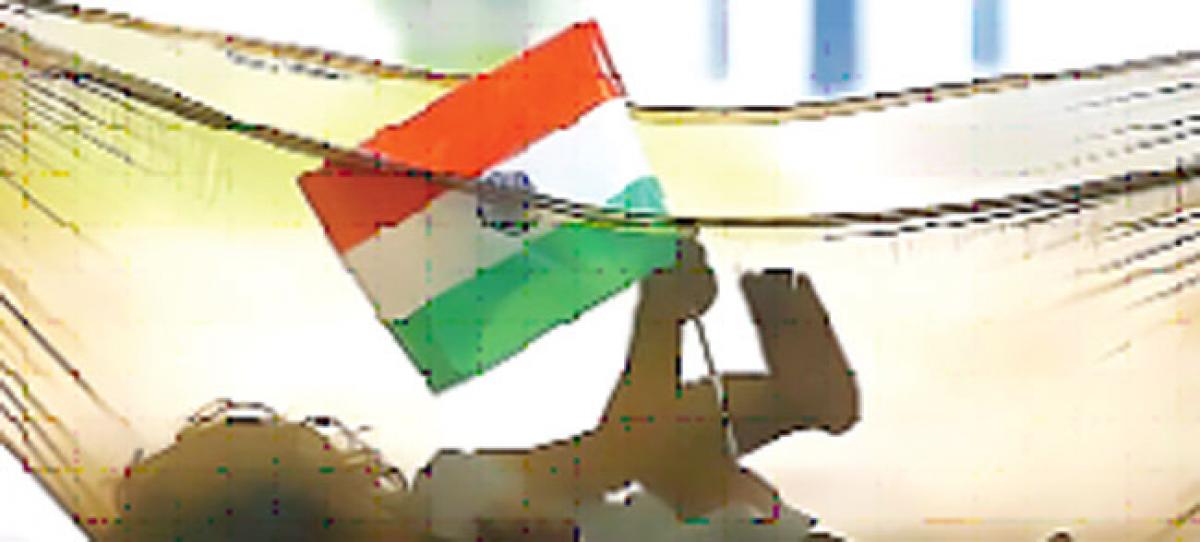Live
- PIL in SC seeks direction to designate BMC as sole planning, sanctioning authority for Mumbai
- 3rd Test: Centuries from Head, Smith help dominant Australia feast on listless India
- AAP final list of 38 names in Delhi: Kejriwal, CM Atishi retain seats
- Tributes Paid to Sardar Vallabhbhai Patel on His Death Anniversary at CM Revanth Reddy's Residence
- In just one year, Bhajanlal govt wins hearts of people
- CM Chandrababu announces establishment of Potti Sriramulu Telugu University
- Sutume, Kissa win World 25K Kolkata; India's Gulveer makes course record
- US accounts for 18 per cent of Indian exports in FY24
- Will end Naxalism in Chhattisgarh by March 2026: Amit Shah
- Will gift one project daily to people during Jan Kalyan Parv
Just In
Isn’t syncretic politics the best choice for India?


India, for fairly an extended time, has been impoverished of the best substitute, as far as political alternatives are concerned Syncretic politics or what is also known as spectralsyncretic, which refers to politics outside the conservative leftright political gamut, would serve the best for India
India, for fairly an extended time, has been impoverished of the best substitute, as far as political alternatives are concerned. Syncretic politics or what is also known as spectral-syncretic, which refers to politics outside the conservative left-right political gamut, would serve the best for India.
The ideologies of each and every political party have some virtues and shortcomings. As opposed to sternly following a particular political ideology, one may ascertain both vividness and faintness within most of the political parties, and aspire to grip all those hopeful features while simultaneously disowning the cynical features.
The central inkling of syncretic politics is to realise a goal of reconciliation. In order to achieve the same, the concept of syncretic politics takes political situations of a neutral stance into account and combines the components related to the left and right ideologies in an appropriate manner.
Spectral-syncretic refers to quite heterogeneous approaches because it is defined by the annulment of the two standard poles of a given simplistic political field. This approach ultimately paves a way to what is called a Third Way.
The term ‘third way’ was familiarised into the construal of American presidential politics by the political scientist Stephen Skowronek. The former U.S. President Bill Clinton, during his regime, firmly adopted and fairly redefined this style of governing. In the U.S., the ‘third way’ group supports for socially-liberal positions, while advocating a fiscally-conservative approach to public expenditure.
If we take the poll verdicts in India into consideration, it is palpable that over a period of time no political party has attained popular majority apropos the percentage of balloted votes (not taken 2014 general elections into consideration).
This point designates clearly that the voters are not inclined to any one particular political ideology. In this milieu, the thought of syncretic politics could institute a ‘Big Tent’. A ‘big tent’ or ‘catch-all party’ is a type of political party that hunts for attracting voters from dissimilar points of view and ideologies.
One such alternative is third parties, a conglomeration of many parties that oppose the major political parties within the left-right political spectrum. However, in a vast country like India, third parties are not sustainable on a national scale. The same has been proven time and again. But definitely, the third parties give an opportunity for expression of unorthodox ideas despite the fact that as a practical matter it ends up as barely anything.
It is a matter of fact that a political party that comprises persons with unreliable principles is sure to be ineffectual. Also, contrariwise, a political party that discards persons with innovative notions is ordained to perish. The major hol
-up for ‘catch-all party’ politics is accurately balancing the act of isolating the conflict of ideological premises from the conflict of competing policies and programs. For an efficacious ‘Big Tent’ based on syncretic politics, there is a need to take the people and the professional organisations that represent the people who generally have ideas about government into account.
It is for the reason that they have a clear idea of what and what not is expected out of the administrating governments. Thus, the origin of syncretic political ideology rests with the people, for it is from them the rationality of policy and program is multiplied.
In the prevalent Indian set-up, there is a vast scope for any political party that adopts a syncretic political ideology. Instituting such an ideology may take place both within and outside the political parties. The press, the universities, local civic bodies, and clubs may turn out to be other potential stakeholders for contemplating such an ideology. Ideas put up with the logic of educational programs undertaken by the aforesaid stakeholders would thus form the backbone vertebra of syncretic political ideology.
Before wrapping up, it should be understood that syncretic politics is nothing but an ideal mix of both old and recent ideas inside politics. As the elections in five Indian states and 2019 general elections are looming, there is a way drawn out for the third parties amidst the jostling within the other major political parties. However, as the people are apparently looking for a change in the political approach of parties, the position ambitious political parties may contemplate about syncretic political ideology. (The author is an Air Veteran & A Mass Communicator — Author of More than 10 Mass Media Books)

© 2024 Hyderabad Media House Limited/The Hans India. All rights reserved. Powered by hocalwire.com






